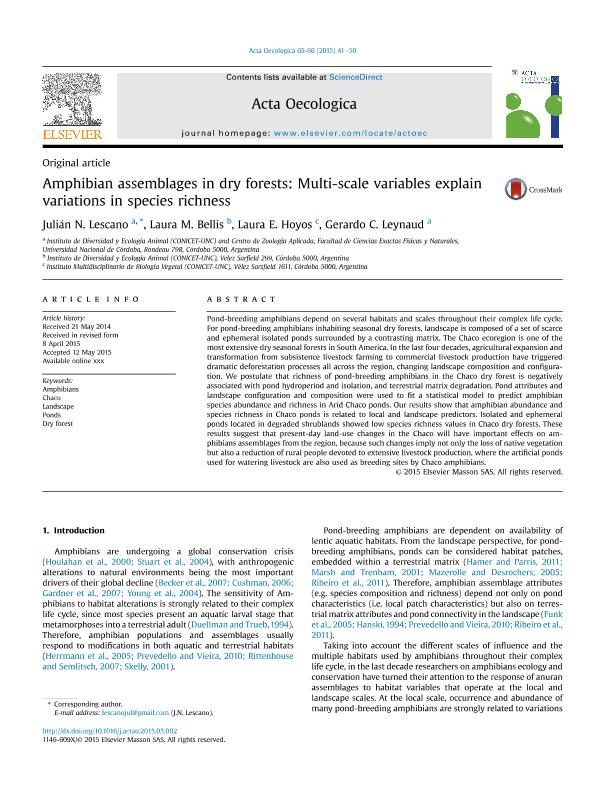Mostrar el registro sencillo del ítem
dc.contributor.author
Lescano, Julián Norberto

dc.contributor.author
Bellis, Laura Marisa

dc.contributor.author
Hoyos, Laura Emilia

dc.contributor.author
Leynaud, Gerardo Cristhian

dc.date.available
2016-11-02T19:09:22Z
dc.date.issued
2015-05
dc.identifier.citation
Lescano, Julián Norberto; Bellis, Laura Marisa; Hoyos, Laura Emilia; Leynaud, Gerardo Cristhian; Amphibian assemblages in dry forests: Multi-scale variables explain variations in species richness; Elsevier; Acta Oecologica; 65-66; 5-2015; 41-50
dc.identifier.issn
1146-609X
dc.identifier.uri
http://hdl.handle.net/11336/7922
dc.description.abstract
Pond-breeding amphibians depend on several habitats and scales throughout their complex life cycle. For pond-breeding amphibians inhabiting seasonal dry forests, landscape is composed of a set of scarce and ephemeral isolated ponds surrounded by a contrasting matrix. The Chaco ecoregion is one of the most Extensive dry seasonal forests in South America. In the last four decades, agricultural expansion and transformation from subsistence livestock farming to commercial livestock production have triggered dramatic deforestation processes all across the region, changing landscape composition and configuration. We postulate that richness of pond-breeding amphibians in the Chaco dry forest is negatively associated with pond hydroperiod and isolation, and terrestrial matrix degradation. Pond attributes and landscape configuration and composition were used to fit a statistical model to predict amphibian species abundance and richness in Arid Chaco ponds. Our results show that amphibian abundance and species richness in Chaco ponds is related to local and landscape predictors. Isolated and ephemeral ponds located in degraded shrublands showed low species richness values in Chaco dry forests. These results suggest that present-day land-use changes in the Chaco will have important effects on amphibians assemblages from the region, because such changes imply not only the loss of native vegetation but also a reduction of rural people devoted to extensive livestock production, where the artificial ponds used for watering livestock are also used as breeding sites by Chaco amphibians.
dc.format
application/pdf
dc.language.iso
eng
dc.publisher
Elsevier

dc.rights
info:eu-repo/semantics/openAccess
dc.rights.uri
https://creativecommons.org/licenses/by-nc-sa/2.5/ar/
dc.subject
Amphibians
dc.subject
Chaco
dc.subject
Landscape
dc.subject
Dry Forest
dc.subject.classification
Conservación de la Biodiversidad

dc.subject.classification
Ciencias Biológicas

dc.subject.classification
CIENCIAS NATURALES Y EXACTAS

dc.title
Amphibian assemblages in dry forests: Multi-scale variables explain variations in species richness
dc.type
info:eu-repo/semantics/article
dc.type
info:ar-repo/semantics/artículo
dc.type
info:eu-repo/semantics/publishedVersion
dc.date.updated
2016-11-02T18:14:44Z
dc.journal.volume
65-66
dc.journal.pagination
41-50
dc.journal.pais
Francia

dc.journal.ciudad
Paris
dc.description.fil
Fil: Lescano, Julián Norberto. Consejo Nacional de Investigaciones Cientificas y Tecnicas. Centro Cientifico Tecnologico Cordoba. Instituto de Diversidad y Ecologia Animal; Argentina
dc.description.fil
Fil: Bellis, Laura Marisa. Consejo Nacional de Investigaciones Cientificas y Tecnicas. Centro Cientifico Tecnologico Cordoba. Instituto de Diversidad y Ecologia Animal; Argentina
dc.description.fil
Fil: Hoyos, Laura Emilia. Consejo Nacional de Investigaciones Científicas y Técnicas. Centro Científico Tecnológico Córdoba. Instituto Multidisciplinario de Biología Vegetal (p); Argentina
dc.description.fil
Fil: Leynaud, Gerardo Cristhian. Consejo Nacional de Investigaciones Cientificas y Tecnicas. Centro Cientifico Tecnologico Cordoba. Instituto de Diversidad y Ecologia Animal; Argentina
dc.journal.title
Acta Oecologica

dc.relation.alternativeid
info:eu-repo/semantics/altIdentifier/url/http://www.sciencedirect.com/science/article/pii/S1146609X15000533
dc.relation.alternativeid
info:eu-repo/semantics/altIdentifier/doi/http://dx.doi.org/10.1016/j.actao.2015.05.002
Archivos asociados
